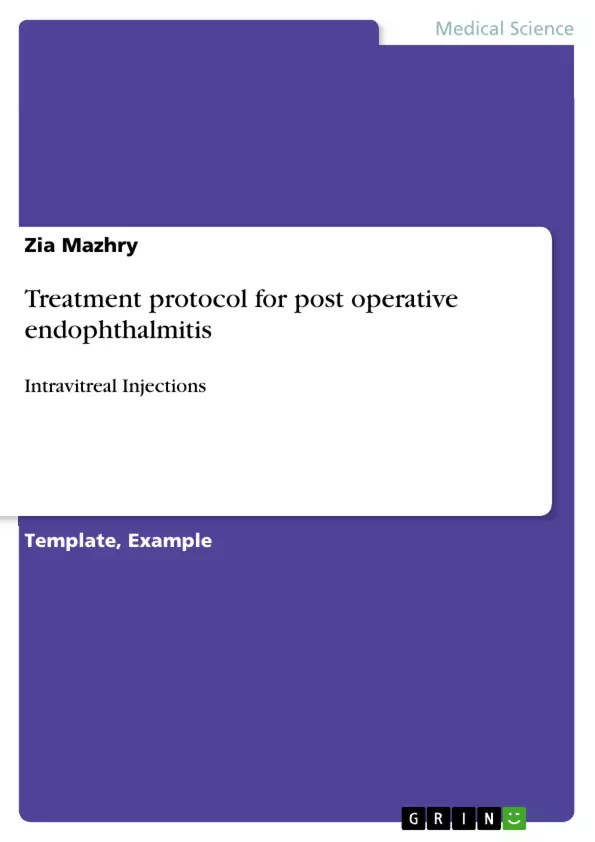Endophthalmitis is a devastating complication of ocular surgery and trauma, which may lead to total loss of vision and sometimes even the eyeball. Management of endophthalmitis presents one of the most challenging problems in ophthalmology. Two third of all cases of endophthalmitis occur after surgery. 90% are caused by bacteria and the remaining 10% by fungi, viruses and parasites. Incidence reported in literature is 0.1% to 0.4%. Though no study is available, incidence in our setup seems to be even higher.
Traditionally endophthalmitis had been treated with topical and systemic antibiotics given both orally as well as parenterally but with poor therapeutic response. Another mode of treatment that has now become the standard treatment for endophthalmitis in developed countries is intravitreal injection of antimicrobials. Studies have proven this to be an effective, probably the only effective treatment available so far. In Pakistan this way treatment has not yet been widely practiced.
The authors have carried out a study on 56 eyes diagnosed as cases of endophthalmitis. The patients were treated with intravitreal injections. Results were encouraging. Anatomical integrity was preserved in 90% of cases and 60% had a visual acuity of 6/60 or better. A gold medal winning paper was presented by one of the authors in Ophthalmo 96 based on the above study. Great enthusiasm was shown about the technique. The Chairman of the conference advised to publish the technique.
The aim of this booklet is to present in a simple way the management of endophthalmitis using the technique of intravitreal injections. Secondly we want to decrease the undue hesitancy and fear about the use of intravitreal injections. By the end of the booklet the reader will feel confident to practice the procedure on his own whenever and wherever needed.
Inhaltsverzeichnis (Table of Contents)
- Diagnosis and Management Plan For Endophthalmitis
- Early symptoms.
- Late symptoms.
- Early signs.
- Late signs.
- Important.
- Management plan.
- Drug Doses and Preparation of Intravitreal Injections.
- Antifungals.
- Steroids.
- Preparation of intravitreal injections.
- Procedure and Technique.
- Choice of antimicrobials
- Anesthesia.
- Site.
- Vitreous aspiration and injection
Zielsetzung und Themenschwerpunkte (Objectives and Key Themes)
This booklet aims to provide a straightforward guide to managing endophthalmitis using intravitreal injections. It seeks to address the hesitancy and fear surrounding this technique, empowering readers to confidently implement the procedure when needed.
- The efficacy of intravitreal injections in treating endophthalmitis.
- The diagnosis and management plan for endophthalmitis.
- The use of antibiotics and antifungals in intravitreal injections.
- The procedure and technique of intravitreal injection.
- The importance of early recognition and intervention in endophthalmitis.
Zusammenfassung der Kapitel (Chapter Summaries)
The booklet begins by outlining the early and late symptoms and signs of endophthalmitis, emphasizing the critical role of early detection in successful treatment. A detailed management plan is then presented, outlining the steps to take depending on the severity of the condition. The booklet then provides information on the types and dosages of antibiotics and antifungals used in intravitreal injections, with specific instructions on preparing the injections. Finally, the procedure and technique of intravitreal injection are explained in detail, including the choice of antimicrobials, anesthesia, injection site, and the process of vitreous aspiration and injection.
Schlüsselwörter (Keywords)
Endophthalmitis, intravitreal injections, antibiotics, antifungals, steroids, diagnosis, management, procedure, technique, vitreous aspiration, injection site.
- Quote paper
- Zia Mazhry (Author), 2014, Treatment protocol for post operative endophthalmitis, Munich, GRIN Verlag, https://www.grin.com/document/283205



